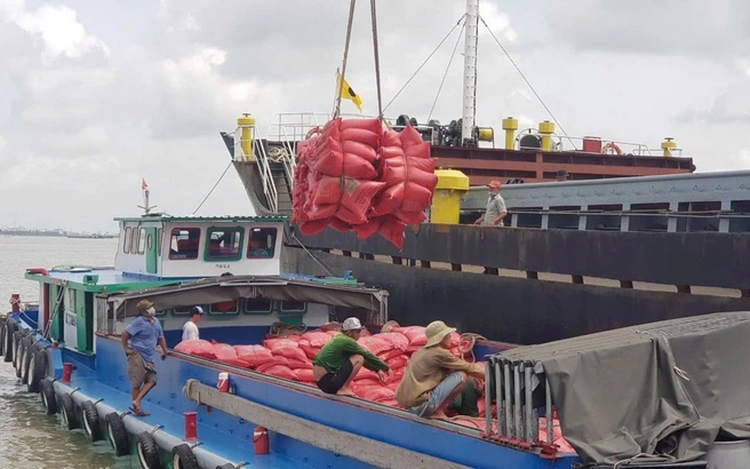
Vietnamese rice is loaded for export at My Thoi Port in An Giang Province, southern Vietnam. Photo: Buu Dau / Tuoi Tre
In a significant development for the global rice market, the Philippine Department of Agriculture recently hinted at the potential extension of its rice import suspension until the end of 2025. This announcement extends beyond the previously expected period of just September and October, raising alarms among rice exporters in Vietnam—its largest rice supplier.
As the Philippines weighs this decision, local exporters are compelled to reevaluate their strategies. Phan Van Co, marketing director of Vrice Co. Ltd., articulated the concerns, stating that even as the Philippines pauses its rice imports, certain commercial agreements with Indian rice exporters are still actively being fulfilled under specific conditions. This prompts Vietnamese rice exporters to explore new avenues and markets.
“Our long-standing approach has been to avoid reliance on a single market,” Co remarked. “While the Philippines contributes around 30–40 percent of our total rice exports, we are diversifying our focus toward African markets.” Nevertheless, he cautiously noted that African markets generally favor Indian rice, posing a challenge for Vietnamese exporters.
High logistics costs and payment risks further complicate the situation. Presently, Vietnam’s rice exports primarily consist of aromatic varieties, while the supply of white rice remains limited. A recent ban on white rice imports from Cambodia has also strained domestic stockpiles.
Many major exporters are reluctant to enter new contracts—not due to a lack of buyers, but because market prices are low, profit margins are thinning, and the conditions are shifting rapidly. “Businesses are waiting for clearer information,” Co added, summing up the uncertainty prevalent in the sector.
Emerging Markets and Growth
Despite the challenges posed by the Philippine import suspension, Vietnam’s rice sector is experiencing growth in alternative regions. The Vietnam Food Association reported remarkable increases in rice exports to Ghana, which has emerged as a significant importer, making up nearly 22 percent of total Vietnamese rice exports. Following Ghana, Côte d’Ivoire accounts for 21 percent, with Malaysia contributing another 10 percent of exports.
Bangladesh is also gaining as a target market, while rice exports to China have surged more than 141 percent year-on-year, showing the potential for recovery after a prolonged decline.
Future Concerns for 2026 Exports
Looking ahead, Vietnamese rice exporters are grappling with concerns about a looming global rice surplus and its implications for contracts slated for delivery in 2026. As the winter-spring crop season peaks in March and April, traditional pricing for aromatic rice hovers around VND13,000–14,000 (approximately US$0.49-0.53) per kilogram. However, current market prices have dipped to VND10,000–11,000 ($0.37-0.41) per kilogram—reflecting a troubling downward trend.
“Companies are strategizing to sell domestically, tap into new markets, and meticulously manage their inventories,” Co explained. “As we approach the end of 2025, our apprehensions about price pressures in early 2026, particularly during the peak harvest season, are growing.”
Vietnam has set an ambitious rice export revenue target of $5.7 billion for 2025, which brings forth additional challenges for exporters. A number of firms are pivoting their focus towards the EU, South Korea, Japan, and Singapore as new prospective markets.
A rice exporter based in Ho Chi Minh City shared insights on the evolving strategies, stating, “We’re exploring additional export markets and diversifying raw material sources to alleviate tax pressures and minimize dependency on any single market. We are also evaluating rice-derived processed products like noodles, vermicelli, and rice paper.”
Efforts to collaborate with other businesses aim to mitigate logistics costs when venturing into promising markets such as Ghana, Côte d’Ivoire, and the UAE, offering both aromatic and white rice varieties.
Challenges from Domestic Conditions
Despite these dynamic strategies, rice exporters in Vietnam face dual challenges: the repercussions of the Philippines’ import ban and complications associated with new VAT refund regulations effective from July 1. A representative from the Vietnam Food Association indicated that the domestic rice market in the Mekong Delta has stagnated, with traders hesitant to purchase due to concerns about limited export opportunities.
Should these conditions persist through the end of the year, exporters could incur losses, while farmers might see their incomes decline due to falling paddy prices. In light of this pressing situation, the association has formally requested that the Ministry of Industry and Trade reach out to the Philippine Department of Agriculture to address challenges and ensure that Vietnamese businesses can continue their export operations.
In addition, they seek clear guidance on which rice varieties are impacted by the proposed temporary suspension, a request based on a memorandum of understanding on rice trade cooperation signed between the two countries on January 30, 2024, which is set to remain valid until December 31, 2028.